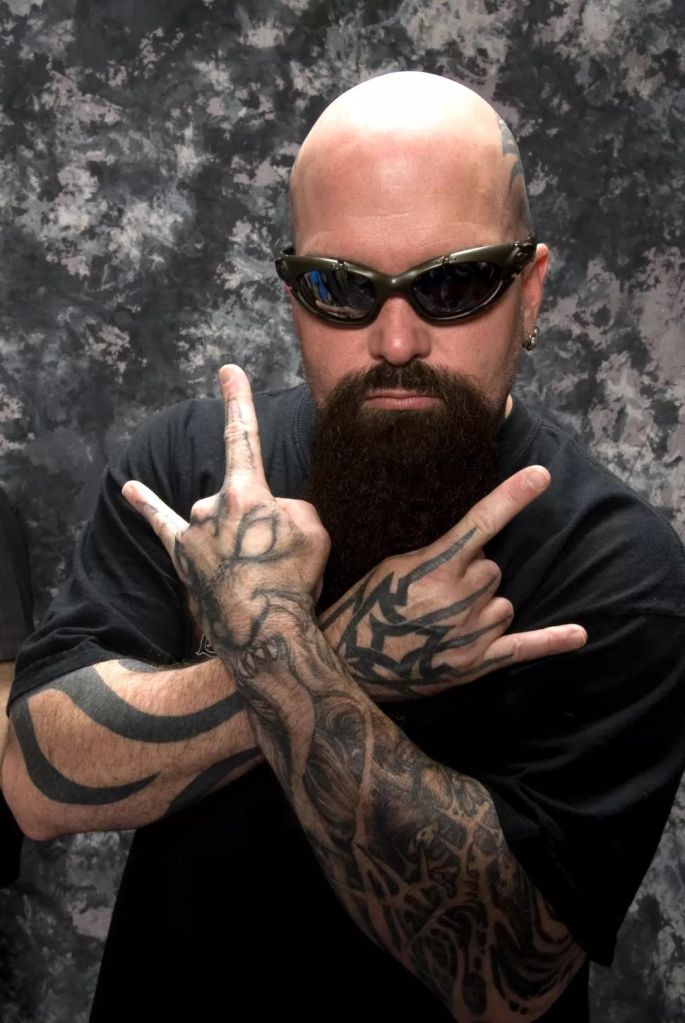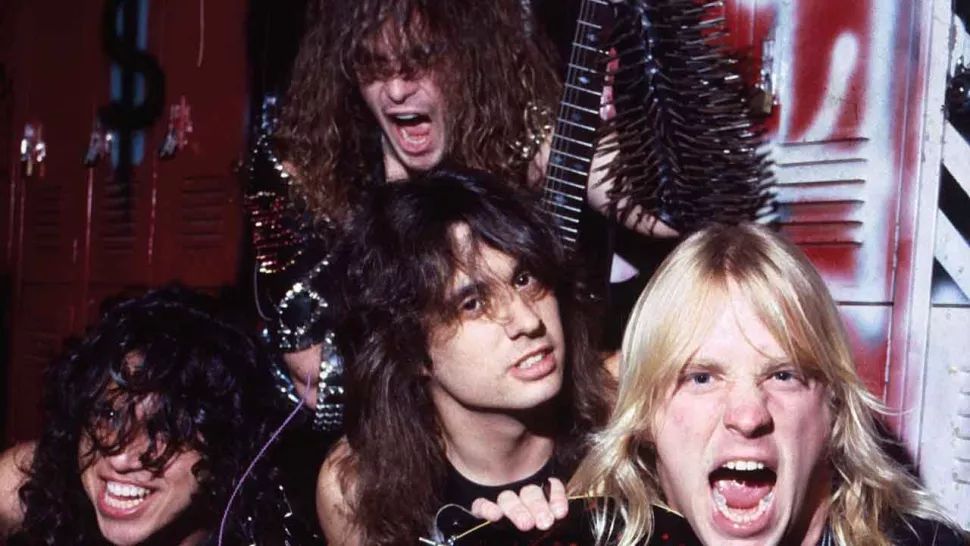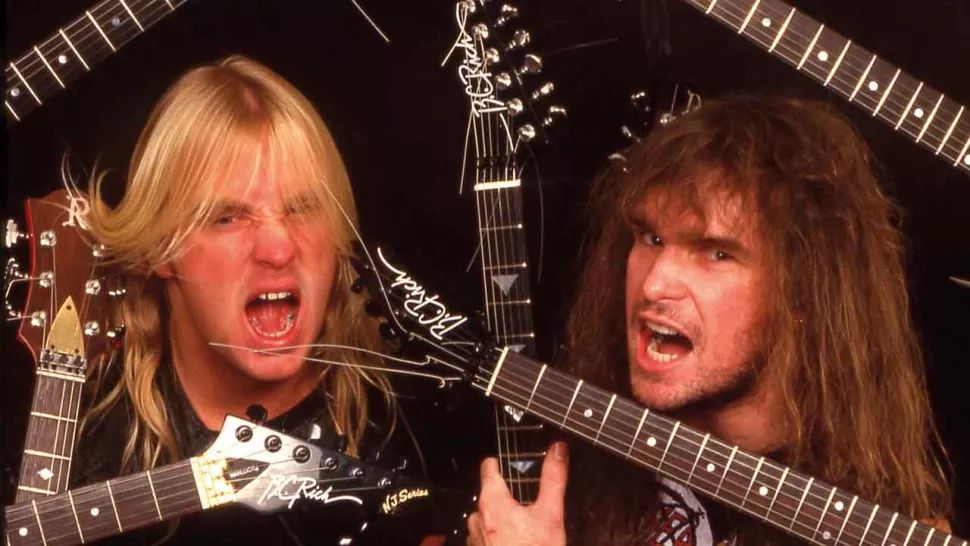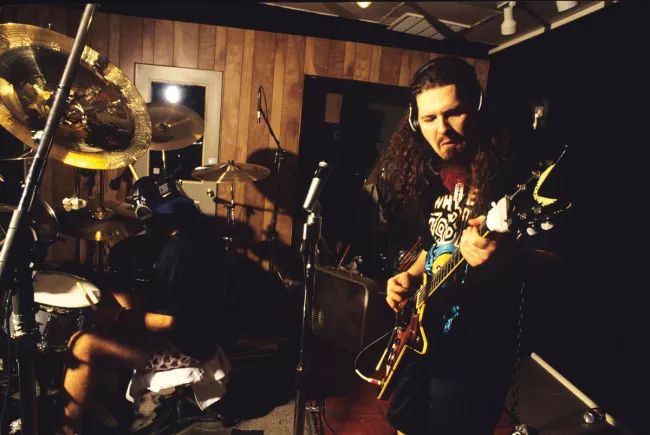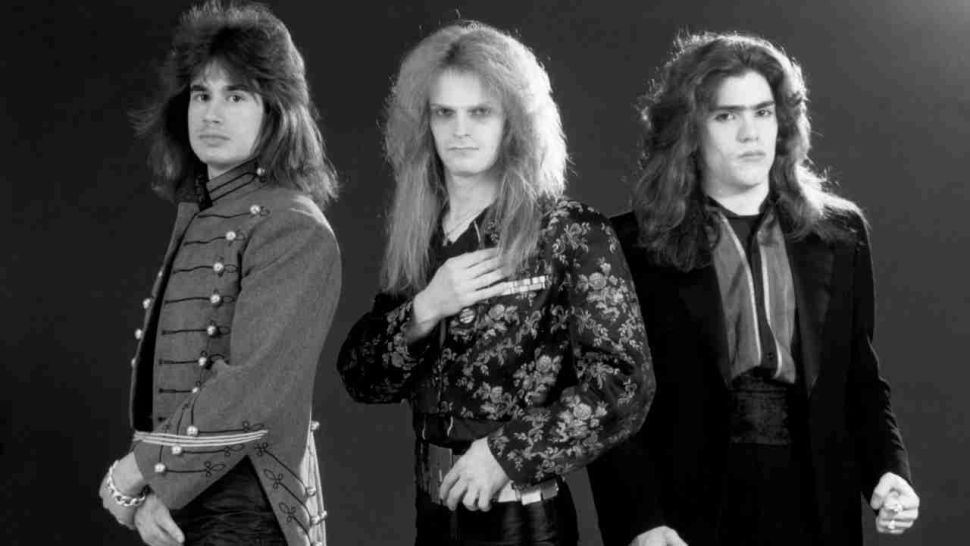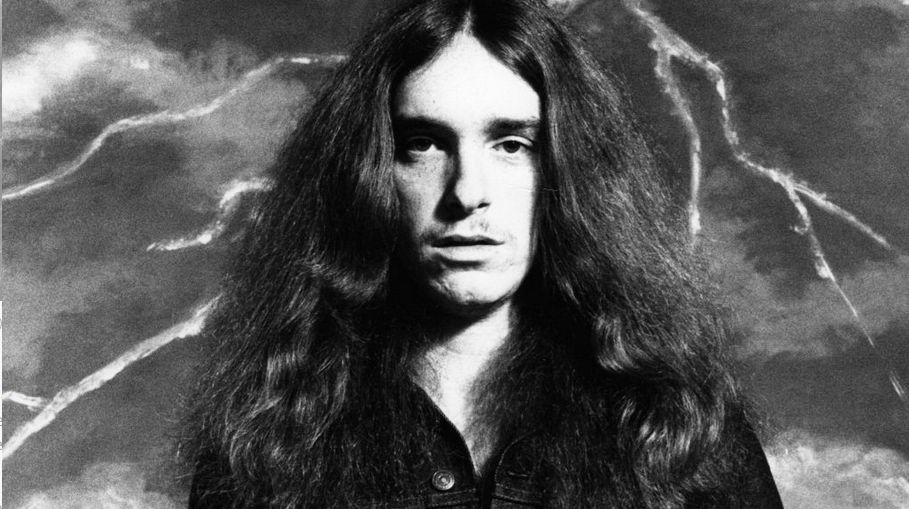No One Hits Harder Than Vinnie Paul: A Tribute Interview
Tag: metallica
Happy Birthday Cliff!
Cliff Burton was born on this day in 1962 in Castro Valley, California.
Jeff’s Week on Metal Graveyard: Slayer – The Making Of ‘Reign In Blood’
source: Metal Hammer
Slayer: The Making Of Reign In Blood
Jeff’s Week on Metal Graveyard: “Let’s Be Brutal, Evil and Dark”. The Epic Oral History of Slayer’s ‘Reign In Blood’
source: Metal Hammer October 07, 2020
“Let’s Be Brutal, Evil and Dark”: The Epic Oral History of Slayer’s ‘Reign In Blood’
Kerry King, Tom Araya, Dave Lombardo, Rick Rubin and more look back on the making of one of the greatest albums in metal history
When they bowed out in 2019, Slayer left an almighty legacy. One of the founding fathers of thrash metal, they helped turn it from a feral underground movement into a game-changing force of nature, whose impact can still be heard today. Their records, from 1983’s Show No Mercy through to 2015’s Repentless, stand among metal’s holy texts.
But one thing towers above everything. Released on October 7, 1986, Reign In Blood isn’t just Slayer’s greatest album, it’s up there with the greatest albums ever made, by any band in any genre: 28 eight minutes and 58 seconds of unbridled power and undiluted intent that drew awe, acclaim and controversy in equal measure. More than anything else, Reign In Blood will be what Slayer are remembered for in decades to come.
“We never realised how special it was when we were working on it,” guitarist Kerry King tells Metal Hammer. “We knew it was cool but we never thought it was what people would talk about for the next 30 years.”
King, along with singer/bassist Tom Araya, original drummer Dave Lombardo, producer Rick Rubin and several other friends and contemporaries of Slayer, look back on that landmark album. This is the blow-by-blow story of how Reign In Blood changed the world forever…
By 1985, Metallica had emerged as the leaders of the thrash metal pack. But Slayer weren’t that far behind them. Their first two albums – 1983’s Show No Mercy and 1985’s Hell Awaits, released on US underground label Metal Blade – proved they weren’t content just to exist in the shadow of James Hetfield and Lars Ulrich.
Kerry King: “I look back on that time just before Reign In Blood, and it was totally exciting being a member of Slayer. You’d walk down the street and people would know your face and name. It was weird. It was the only time I got a big head.”
Don Kaye (US metal journalist): “The first two Slayer albums and the EP came out on Metal Blade. They were really solid. Everybody was flipping out over them.”
Brian Slagel (owner, Metal Blade): “By the time they got to Hell Awaits, you could see how much better they were. Especially Dave – he was a phenomenal drummer, and he really upped his game big-time on Hell Awaits.”
Tom Araya: “Songwise, we were writing material that was really heavy – long but heavy. At the time, that’s what everybody was doing. We thought, ‘We can do that.’ But were growing all the time.”
Dave Lombardo: “We knew Hell Awaits was good, but we were itching to get onto the next thing.”
Tom Araya: “The only thing that we knew about the next album was that it was gonna be faster than Hell Awaits.”
The Hell Awaits campaign hadn’t finished, but Slayer were already planning their next move. They were on friendly terms with their contemporaries in the thrash scene, but they knew they had it in them to deliver something that would leave every other trailing in their wake.
Dave Lombardo: “We were getting cocky. We had already released two albums and been on tour.”
Tom Araya: “Right at the end of the Hell Awaits period, Jeff [Hanneman, guitarist] and Kerry were constantly putting ideas together, coming up with new stuff.”
Dave Lombardo: “Before, we would all sit together and bang out the songs. But Jeff had invested in recording equipment and he started recording his own demos complete with the basic drum pattern, guitar riffs, some arrangements. And then he would present us with cassettes. It was awesome, because it gave us a clear picture of where he was going.”
Tom Araya: “Jeff had become a fan of a lot of West Coast punk. There was this record store where he’d go a lot and look for album covers. He figured the cooler the cover, the better the band. Then he’d bring it in and play it all the time.”
Dave Lombardo: “TSOL, Minor Threat, Dead Kennedys, Circle Jerks… Jeff was discovering new bands all the time. It was definitely a turning point.”
Tom Araya: “The last one on the wagon was Kerry – he was more of a metalhead. He didn’t understand it at first. Eventually he started like it – if you get hit in the head with something enough, eventually you start liking it.”
Kerry King: “There was a camaraderie between the thrash bands at the time. I’d get the other guys’ records, just to see what they were doing.”
Dave Lombardo: ‘We were keeping tabs on what they were doing. We’d listen to other bands and go, ‘That’s weak, we could do better than that, we’re more brutal than that.’”
Tom Araya: “Everybody else was doing something slow. Kerry and Jeff said that they didn’t want to do a slow record, they wanted to do something fast. They didn’t realise it was gonna be that fast…”
Don Kaye: “I think their goal was to out-heavy and out-speed Metallica.”
Brian Slagel: “On Reign In Blood, I think that was the single focus: ‘We want to make the fastest, heaviest record that’s ever been done.’”
It didn’t take long for more clued-in major label A&R executives to spot thrash metal’s potential. In 1984, Metallica were picked up by Elektra Records, and the following year it was Slayer’s turn to be courted by the big boys.
Brian Slagel: “Metal Blade were a small little label and the band were getting really big. We knew they were going to sign with a major label, just because it made sense at that point.”
Don Kaye: “Metallica had signed to Elektra, but nobody really expected Slayer to get a major deal at the time because they were so heavy.”
Brian Slagel: “We had meetings with Capitol, and with Warner Brothers. I think at that point pretty much every label was interested in them because metal was a big thing happening then. Metallica were starting to really take off.”
Tom Araya: “That’s when we realised that there were record companies that were interested.”
Brian Slagel: “Rick Rubin, who was head of Def Jam Records, approached us. Def Jam was a hip hop label. They’d put out records by Run DMC and people like that. But Rick was a fan of punk and metal, too.”
Dave Lombardo: “We had already signed a multi-album deal with Metal Blade. I caught wind of interest of a major label in New York – Columbia – that wanted us. So I told the guys about it and they were, like, ‘No Dave, we’re already signed to Metal Blade, it’s too much, we can’t get out of the contract.’ I’m like, ‘Wait, we should check this out and see what they have to say.’”
Rick Rubin: “I first met them at their show at The Ritz in NYC. I knew nothing about them before the show and they blew me away.”
Tom Araya: “Somebody goes, ‘Hey, I want you to meet Rick Rubin. He’s this guy from Def Jam.’ We’re like, ‘Def Jam?’”
Kerry King: “Was I a fan of hip hop? I wasn’t, no.”
Tom Araya: “It was a little strange, but we knew that he was a fan and that was the extent of it. And that was one of the luckiest things ever – here’s this guy who’s just got a shitload of money from major record labels, and he wants to work with us and he’s a fan. You can’t beat that.”
Brian Slagel: “Rick wanted it more than anybody else and he went after the band hard. He said, ‘Hey if you come with me, I’ll do this and this and this’, and they chose to go with him.”
In June 1986, Slayer entered Hit City West Studios in Los Angeles with Rubin and engineer Andy Wallace to begin work on the album that would become Reign In Blood. Rubin’s vision for the album was to boil everything down to the bone, capturing the album live and stripping it of unnecessary reverb.
Dave Lombardo: “The studio was just a little place on Pico and La Cienega Boulevard. It wasn’t elaborate.”
Tom Araya: “We were a bunch of young kids. We didn’t really have anyone working with us. We brought our own stuff in, we set up our own stuff. It was us and my brother John, who came in and set up all our gear and mic’d it up for us. But this was our first record with someone that was a pro.”
Dave Lombardo: “Andy Wallace was there – he’s an amazing engineer. He had a very Zen-like personality. He was very mellow, a very nice guy. He wasn’t a party animal or anything. He basically held the fort when Rubin wasn’t there.”
Brian Slagel: “There’s a couple songs that had actually almost ended up on Hell Awaits. Altar Of Sacrifice was one of them. You could kind of see the early makings of where that record was going.”
Rick Rubin: “What surprised me most was that Jeff and Kerry both knew which solos were good and which weren’t, since at the time, none of the solos made sense to me. It’s as if they were speaking a different musical language than the rest of the world.”
Dave Lombardo: “The sessions used to start very late – 10 or 11 o’clock – and would go to the early hours of the morning. I honestly don’t know why. The Witching Hour, maybe, ha ha ha! Midnight to three in the morning was the best time to conjure the most evil.”
Kerry King: “What else were we fuelled by? Nothing. I didn’t even drink yet. It wasn’t a party.”
Dave Lombardo: “We were so well-rehearsed before we went into the studio. I believe I recorded my tracks in three or four days. There were no computers, no software. It was well-rehearsed: get your tempo down, press record and don’t fuck up.”
Tom Araya: “Rubin tweaked our guitar sounds. Other than that, we just kept recording until he said, ‘I got that one.’”
Kerry King: “Somebody at some time said, ‘You don’t need reverb to be good.’ Once we got that in our heads, we were like, ‘OK, that’s pretty fucking tight.’”
Rick Rubin: “It’s very close to being a live album, very well recorded in a studio. Slayer didn’t sound like anyone else, that’s why the album sounds different than other metal albums. They really were creating their own genre.”
The 10 tracks that constituted Reign In Blood lived up to Slayer’s ambition of being faster and more brutal than any other band. They dialled back Hell Awaits’ Satanic shtick in favour of a lyrical approach that was one part gruesome medical textbook, one part Hieronymus Bosch painting – most notably on instantly iconic opening track Angel Of Death, which was inspired by the infamous Nazi surgeon Dr Josef Mengele.
Tom Araya: “Did I have any problem singing the lyrics on Angel Of Death? No, I didn’t. When Jeff brought in the song, we thought, ‘Wow, that’s really cool – this was the guy that did all those crazy, terrible things.’”
Dave Lombardo: “It was, ‘Let’s be brutal. Let’s be evil, dark.’ I thought it was great.”
Tom Araya: “As usual, we always end up finishing a song in the studio, while we’re in the process of doing it. On that one, it was Raining Blood. That was the song that didn’t have any lyrics.”
Kerry King: “I remember finishing the lyrics to Raining Blood in the lobby of the studio. I think Jeff was doing some of the tracks inside. He had no ideas for the part I was working on, so it was, like, ‘Here, let me try. I finished it.’”
Dave Lombardo: I think my favourite point on the album is Postmortem into Raining Blood. That piece is monstrous. It’s epic how it flows from one song to the other.”
Tom Araya: “The only thing was that we told Dave to speed it up – ‘Hey Dave, c’mon, speed it up, pick it up a bit!’”
Dave Lombardo: “Rubin and the band were saying, ‘Let’s push a little more… a little more aggressive… get angry.’”
Tom Araya: “All 10 songs came in at 28 minutes. A full album, contractually, constitutes at least 45 minutes of music. I asked Rick if that was OK. His only reply to any of that was, ‘It’s 10 songs, which constitutes an album. There’s verses and leads and choruses.’ He didn’t have an issue with it, which was really cool.”
Rick Rubin might not have had a problem with the album, but somebody else certainly did. Def Jam’s releases were distributed by Columbia Records, whose president, Walter Yetnikoff, objected to Angel Of Death. Walter, who was Jewish, viewed the song as anti- Semitic and refused to release the album unless the opening track was pulled. Slayer refused.
Tom Araya: “All of a sudden, the record company doesn’t want to release the album. We were, like, ‘Fuuuuuck…’”
Kerry King: “I didn’t know shit about the world at that point. I thought, ‘That is the most ridiculous thing I have ever heard.’”
Dave Lombardo: “When Rubin told us that Columbia were backing out, he said, ‘Guys, don’t worry about it. I have another company. This is kind of cool, we could spin it in a way that it could be of advantage to us.’”
Kerry King: “The funny thing is that it was already paid for: ‘All you gotta do is market it, it’s gonna sell.’ The world’s a weird place.”
Dave Lombardo: “It turned out that Geffen were happy to put the record out.”
Rick Rubin: “Geffen were anxious to be in business with us because of all of the success we were having at Def Jam [with hip hop bands].”
Dave Lombardo: “We just followed Rick and what he wanted to do, and, sure enough, it did work to our advantage because it created a lot of mystery around the album. People were curious.”
Don Kaye: “I don’t actually remember mainstream magazines covering Slayer at the time at all. The only coverage they got in Rolling Stone was when Columbia Records refused to distribute the album because of Angel Of Death.”
The pre-release controversy only served to ramp up anticipation for Reign In Blood, as did the fact that no new music had leaked out onto the tape-trading circuit in advance. When the album was released in the US on October 7, 1986, it was like a thunderclap.
Don Kaye: “I remember a few people voicing the opinion that Hell Awaits was a bit too progressive. Everybody just wanted pure speed from Slayer, and Hell Awaits got into time changes, longer songs. So there was certainly some reservation and curiosity about what about what they were going to do next.”
Brian Slagel: “I was blown away. It was certainly a lot different than Hell Awaits. That had slow stuff and heavy stuff, a lot of different dynamics. This was pretty much just pounding your head in for 29 minutes.”
Kerry King: “At that point, there was no internet. People would say, ‘You gotta listen to this band, you gotta see this band.’ That’s how people did things.”
Slayer kicked off their Reign In Blood tour on Halloween 1986 at The Moore Theater in Seattle. The support band was New Jersey’s Overkill, who’d released their debut album, Feel The Fire, a year earlier.
Rick Sales (Slayer’s manager): “I had just come off an extensive tour road-managing Dokken and I got a call to go out with Slayer a couple of weeks later on their Reign In Blood tour. I was tired and turned it down. A friend of mine called me the next day and told me I should reconsider. As tired as I was, I went out and got a copy of Reign In Blood, and I was hooked. I wanted to be their tour manager so I took the job.”
Bobby ‘Blitz’ Ellsworth (Overkill singer): “Overkill opened for them on that tour. We show up in Seattle, and we’re so excited. And we came out in front of Slayer to a hail of wet paper towels, Zippo lighters and coins thrown at us. The Slayer audience is a tough audience. It’s like, ‘Don’t stop moving and you’re less of a target.’”
Rick Sales: “I saw the frenzy of the music and of the audience – it was a religious experience. It was the most exciting rock show I’d seen since I was a kid and went to see Iggy And The Stooges and MC5. Slayer had an energy, a kind of punk energy.”
Bobby ‘Blitz’ Ellsworth: “We played a place called The Forum in Los Angeles, it was this old building from the 1930s or 40s. I remember somebody falling out of the balcony during Slayer’s set. It wasn’t a push. It was purposeful. It was his way of showing his exhilaration.”
Dave Lombardo: “They would clear the venue and you’d take a walk through afterwards and there’d be pools of blood. It wasn’t just a few little drops here and there. It was like somebody had laid there and bled for a while. It was intense.”
Bobby ‘Blitz’ Ellsworth: “Sure, those gigs were violent. But it wasn’t as if the violence escalated – it was as if someone just pushed a button. You didn’t see the crowd get whipped into this frenzy – the frenzy was instantaneous.”
Kerry King: “After that we toured as the support to WASP. Those guys were bigger than us at that point. They weren’t nice to us. ‘You can’t have lights, you can’t have a smoke machine.’ ‘What? Are you scared of us?’”
Tom Araya: “I think it was on the WASP tour that Dave quit for the first time.”
Kerry King: “I don’t remember why he quit. I think it was probably just a young, growing-up misunderstanding.”
Dave Lombardo: “I had been going on tour and I was coming back with no money to pay my basic bills. I was like, ‘Fuck this, man, I’m not going to put all my fucking effort into this if we’re signed to a major label and going out on these extravagant tours and I’m coming home with no money?’ It just didn’t make sense right now. So I decided to split.”
Tom Araya: “We got Tony [Scaglione, from New York thrashers Whiplash] in for the rest of the WASP tour.”
Dave Lombardo: “I remember Rubin calling me practically every other day: ‘How are you doing? Are you going back?’ No, no, man. ‘Come on, Dave, go back. Let’s work something out.’ And then when I finally decided – ‘Yeah, let’s work this out’ – Rubin flew down and he picked me up and we went to rehearsal and he reintroduced me to the guys. We swept whatever was under the rug and carried on.”
Reign In Blood peaked at No.94 in the US Billboard charts – an impressive feat for such an extreme record. It might not have had the same groundbreaking commercial impact as Metallica’s blockbuster Master Of Puppets, but it took thrash metal to a new level of uncompromising brutality. More than 30 years on, it stands as an eternal benchmark for what metal can and should be.
Don Kaye: “Reign In Blood didn’t feel so much like an evolutionary step as setting a new bar for everything that was going to follow. You’re either going to try and match it or top it, or you’re going to go in other directions.”
Tom Araya: “Why was it successful? I can’t answer that. Maybe it could be that Rick Rubin did it and it came out on a rap label. Maybe it was the controversy. Maybe it was because it was only 28 minutes – everybody else was doing really slow stuff. I don’t know.”
Rick Sales: “They were committed to their art, it was 24/7 for them. It wasn’t, ‘How do we become famous and get Gold records?’ It was strictly, ‘We’re going to make the music we want to and if people don’t like it, fuck ’em.’”
Rick Rubin: “It’s so extreme and at times non-musical… it’s like an assault. I can’t think of another album that does what this album does.”
Don Kaye: “My sense is that other bands knew they couldn’t top it and were just going to try to do their own sort of variations on intensity and speed.”
Brian Slagel: “That record, even more so than Metallica, took extreme and super-heavy metal out to the mainstream kids. It led the way for Pantera and so many other bands who had success. But that was the most extreme record that ever had a massive commercial success. It paved the way for everybody from Cannibal Corpse to Pantera.”
Tom Araya: “My parents were always telling me that I should find a job, maybe go to school, learn something. That way, if all this failed, I wouldn’t find myself out on the street doing nothing. By the time Reign In Blood came out, they realised that we were actually getting somewhere. They were proud.”
Dave Lombardo: “People come up and talk to me about Reign In Blood in the most random places. People yell out, ‘Slayer!’ or come up and say ‘Reign In Blood saved my life.’ That’s one thing I hear a lot. Although the music may have been intense and violent, people have told me that it’s helped them navigate the most horrible times of their lives. That’s just special.”
What If Type O’Negative Wrote Metallica’s ‘Unforgiven’
We’re warming up before Peter’s birthday festival next week.
Here’s another Type O Negative wrote Metallica: This time I took the vocal depths (again) and injected some Type O Negative style into the iconic Metallica’s song ‘The Unforgiven’. So, what if Type O Negative really made this song? Well, take a listen to this version, as my imagination of the combo. R.I.P. Peter \m/
Anniversary of Dimebag’s Death
Darrell ‘Dimebag’ Abbott died tragically on this day in 2004.
source: Metal Hammer December 03, 2019
Why Dimebag Darrell is modern metal’s greatest guitar hero
“Dime was a leader”: Tony Iommi, Zoltan Bathory and Matt Heafy salute legendary Pantera guitarist Dimebag Darrell
Dimebag Darrell wasn’t just a phenomenal musician: he was a revolutionary. Like most of the greatest guitarists in rock history, he played as if the guitar was some magical vestigial limb, as the very essence of his being poured out of him as a bewildering array of ageless riffs and spinetingling lead breaks.
He exerted immeasurable power and influence over the entire metal scene during his career, marching gleefully into uncharted territory time and time again. Unlike most comparable modern metal bands, Pantera simply didn’t need a second guitarist; Dime could do everything, and he did it all with a verve and intensity that could take our breath away.
But aside from that unerring ability to delight and thrill his fans, Dime also commanded the respect and admiration of his peers and even some of those who originally inspired him to pick up a guitar, including Black Sabbath legend Tony Iommi.
“Pantera played with us on a number of Ozzfest tours,” says Tony. “We saw each other quite a lot. Dimebag was lovely guy and great guitarist. He was a leader in their style of music as well as being a really great writer.“
“Generally you have an iconic lead guitarist, or an iconic rhythm guitarist, and Dimebag was an absolute master of both,” says Five Finger Death Punch six-stringer Zoltan Bathory. “That was what made him so special. He was also the guy who put the groove into heavy metal. You heard him play and you thought, ‘Holy shit, there’s something else going on here!’ Live, he would jump off an amplifier and keep playing while switching pickups in mid-air and operating his whammy bar. He did it all. That was his power.”
In the early, formative years of Pantera, Dime remained very much in thrall to the Kiss, Van Halen and Judas Priest records that had first inspired him to pursue a career as a rock star. But even on those somewhat naïve pre-Anselmo albums, there is a strong sense that the guitarist’s naturalistic command of his instrument was evolving into an unstoppable force.
By the time Pantera reached the creative and commercial breakthrough of Cowboys From Hell, Dime had thrown off the shackles of his early influences and seemed to be single-handedly redefining metal, infusing his powerhouse playing with countless unprecedented tricks and quirks, unleashing those trademark riffs and solos via his trusty Randall Century 200 solid state amplifier and aggressively expanding metal’s sonic vocabulary every step of the way.
“Dimebag embodied all the things that a truly well-rounded guitar player should be,” says Trivium’s Matt Heafy. “His rhythm playing could be minimal and catchy, or technical and mindboggling. His lead playing was so heartfelt and melodic that you could sing along with it but it was also jaw-dropping in its revolutionary technique. He had an uncanny ability to create monumental songs.
And it isn’t just metal bands that were inspired by him. You can hear Dime’s influence in every hardcore or metalcore band’s breakdowns, you can feel his solos in every rock band that attempts to utilise those Southern rock-inspired blues bends, and you hear it in every metal band that tries to imitate his hybrid thrash-picking. Dimebag is everywhere.”
The early 90s were a time of great uncertainty in metal. Metallica’s Black Album triumph aside, our world was in a state of flux and in dire need of a hero to lead the charge into the future.
Dime provided that vital service with an insouciant flair, making mainstream metal much heavier than ever before while always exhibiting a sublime gift for writing crushing riffs and melodic parts that were as memorable as they were inventive.
Most of all, Dime’s guitar sound sparked a revolution of its own, paving the way for the sound of virtually every mainstream metal band that followed in Pantera’s imperious wake. But beyond the technical details of Dime’s playing style, he was also a consummate showman – a real, red-blooded, three-dimensional rock star who ruled the stage with supreme confidence.
“He’s had a huge influence on everybody,” says Alter Bridge guitarist Mark Tremonti. “Dime and Zakk Wylde were the two biggest commercial rock guitar players at the time. Losing Dimebag was taking away one of the top two or three guitar players out there at the time.
“There are a lot of great unknown guitar players playing in their bedrooms, but there are few out there doing it and filling arenas. His loss really took something away from the guitar scene. He wouldn’t let you sit there and daydream at a show. He’d wake you up every two seconds. He was such an exciting player. He was wild.”
As original as he was, there were still traces of classic and thrash metal in songs like Domination and Cemetery Gates, of course, but rather than adhering to the unwritten rules of metal guitar, Dime played in a way that suggested a blissful disregard for limitations and a wide-eyed adoration of music’s endless possibilities.
By the time Pantera recorded Vulgar Display Of Power, he was surfing an unstoppable wave of creative inspiration. From the devastating crunch of Mouth For War and Walk to the lavish intricacy of Hollow, that album comprised a sustained barrage of goosebump-inducing masterstrokes that resonate with charismatic power to this day, and the same can be said of the entire post-Cowboys Pantera catalogue. Dimebag’s legacy is vast and the music he made will live forever.
“Heavy metal was born in Europe, basically, and it has a European vibe, which comes from classical music,” notes Zoltan. “Even if you don’t like classical music, you can’t help but be influenced by it. But Dimebag pissed all over music theory… he didn’t give a fuck. Like Eddie Van Halen and Jimi Hendrix, Dimebag just played what he felt. If you never saw him play, you missed the magic.”
What If Type O’Negative Wrote Metallica’s ‘Master of Puppets’
Denis Pauna
This time I took the vocal depths and injected some Type O Negative style into the iconic ‘Tallica song ‘Master Of Puppets’. So, what if Type O Negative really made this song? Well, take a listen to this version, as my imagination of the combo.
Martin’s Week on Metal Graveyard: Celtic Frost’s ‘Into The Pandemonium’ – Story Behind the Album
source: Metal Hammer August 2020
Celtic Frost’s Into The Pandemonium: the madness and the magic of metal’s most visionary album
Martin’s Week on Metal Graveyard: Why I Love Celtic Frost’s Morbid Tales – by Mark Tremonti
source: Metal Hammer February 15, 2019
Why I love Celtic Frost’s Morbid Tales – by Mark Tremonti
By
The Alter Bridge guitarist and extreme metal devotee hails an 80s landmark from Swiss mentalists Celtic Frost
“Growing up and becoming a metal fan, Celtic Frost were right behind Metallica as one of my favourite metal bands. I still remember my friend John introducing me to them with [1987’s] Into The Pandemonium, which I fell in love with. As I used to do, I went and picked up everything I could by them, and this became my go-to record.
“I often see Celtic Frost referred to as one of the most influential, if not the most influential, extreme metal bands in the world. There’s no other band from that scene that drew me in like them. It was the mood and atmosphere they create with this record – and the aggression as well. At that point, I was just a beginner guitarist and songwriter and still developing. But once I started writing, there’s no doubt it influenced me and still does to this day.
“When I heard they were coming to play Orlando as part of their comeback in 2006, I hit the show with a couple of friends. I pushed my way to the rail, hands onstage, and stood there singing every lyric of every single song they played. I was so excited to finally see a band I loved from my childhood as a fan.”
Cliff’s Week on Metal Graveyard: The 10 Best Metallica Songs Featuring Cliff Burton
source: Classic Rock July 19, 2016

